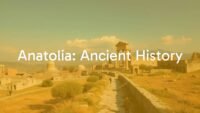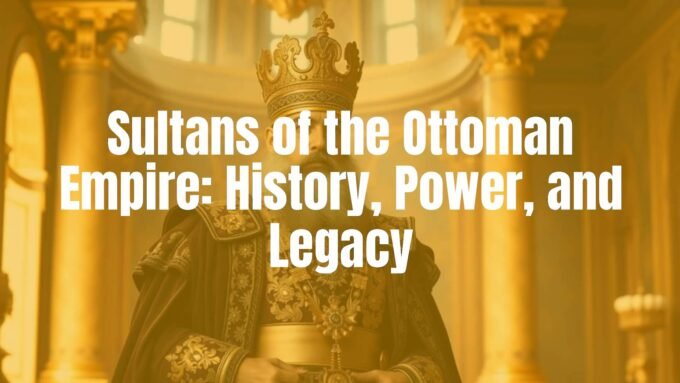The Byzantine Empire, known as the eastern half of the Roman Empire, became a unique and lively civilization that lasted for more than a thousand years after the fall of the Western Roman Empire. Its center was Anatolia, which makes up most of what we now call Turkey. So, what was the Byzantine Empire in today’s Turkey? It continued the traditions of Roman power, Greek culture, and the Orthodox Christian religion, all woven into a land already rich with its own history. Anatolia, also known as Asia Minor, was the empire’s main source of food, soldiers, and a line of defense from both eastern and western threats. With Constantinople (now Istanbul) as its capital, the Byzantine Empire’s history was always tied to this area, deeply shaping both the region and Turkey’s later story.

This article explains how the Byzantine Empire and the area of modern Turkey were connected. We’ll look at the empire’s beginnings, its times of growth and decline, its important cities and historic sites, and the culture and religion that has lived on up to today. The story is one of strength, new ideas, and big changes, showing that Byzantium is still part of Turkey’s deep history.
What Was the Byzantine Empire in the Region of Modern Turkey?
The Byzantine Empire in what is now Turkey was the eastern continuation of the Roman Empire. It kept Roman laws and government systems, but Greek language and customs became more common over time. This mix helped form a new civilization that thrived from the 4th century until 1453. Anatolia wasn’t just another area of the empire-it was often the most important part. Its farmland, people, and location made it valuable, and it acted as a shield against frequent attacks. The empire’s presence in Anatolia involved regularly fighting to keep control and adjust to new dangers, all while holding onto its identity.
How Did Byzantium Develop from Ancient Anatolia to Constantinople?
The path from ancient Anatolia to the Byzantine Empire, focused on Constantinople, is a story of change. Anatolia’s history goes back to ancient times, with kingdoms like Pontus, where King Mithridates VI challenged Rome in 88 BC. Rome eventually took over Anatolia, except for the southeastern border with the Parthians. Under the Romans and then Constantine the Great, Anatolia was mostly peaceful and kept doing well, even after major battles like Chrysopolis between Constantine and Licinius.
Things changed when Emperor Constantine I decided to build a new capital at Byzantium in 324 AD, opening it officially in 330 AD as Constantinople. This city quickly became the empire’s political and economic center. Its location, linking Europe and Asia and sitting between key seas, made it very important. After the Western Roman Empire ended in 476, Constantinople became the main capital, and Anatolia, closely connected to it, became the heart of the empire, helping keep it safe from threats like the Persians and later the Arab Muslims.
Why Is the Byzantine Empire Important in Turkish History?
The Byzantine Empire influenced Turkish history for over a thousand years, ruling much of Anatolia from its capital, Constantinople (Istanbul). Its long rule shaped the area’s people, roads, cities, and even food. When Turks started moving into the region, the change from Byzantine to Turkish rule was a slow mix of fighting and sharing ideas.
The Byzantine Empire’s long defense against outsiders, especially Arab Muslim and Seljuk Turk invasions, helped lay the path for the Turkic takeover. One key event, the Battle of Manzikert in 1071, weakened Byzantine control, allowing more Turkish settlers. The Ottoman Empire later took over, but kept or adapted many Byzantine traditions, from government organization to building design. Learning about Byzantium helps us see how Turkey’s history builds on a mix of Christian and Islamic, Greek-speaking and Turkish customs.
Main Periods of the Byzantine Empire in Turkey
The history of Byzantium in what is now Turkey covers over a thousand years and sees times of growth, trouble, and great change. Here are the most notable periods:
| Period | Main Events |
|---|---|
| 4th-5th Century | Founding of Constantinople; rise of early dynasties; fortification of the capital; continued prosperity in Anatolia. |
| 6th Century | Reign of Justinian I; conquests in the West; major building projects like Hagia Sophia; Justinian’s legal code issued. |
| 7th-8th Century | Repeated invasions by Persians and Arabs; defense focused on Anatolia; the rise of the “theme” (army district) system. |
| 9th-10th Century | Macedonian Renaissance; recovery of lost lands; military and cultural renewal. |
| 11th Century | Seljuk Turk invasions; Battle of Manzikert (1071); rapid Turkish settlement. |
| 13th Century | Empire weakened by the Fourth Crusade; successor states like Nicaea and Trebizond appear. |
| 14th-15th Century | Ottoman advances; final fall of Constantinople (1453); loss of last Byzantine areas in Anatolia (1461). |
Founding of Constantinople and Early Dynasties
The real story of Byzantium begins when Constantine the Great made Byzantium his new capital in 330 AD, turning it into Constantinople. He placed the empire’s center further east, in a better defended and wealthier area. The city grew quickly, helped by its key spot on the Bosporus connecting Europe and Asia. Early dynasties, like the Theodosian, made the city even stronger by building walls and public works. While Western Roman lands suffered invasions, Anatolia and Constantinople largely stayed safe and prosperous, supporting Christian communities and helping shape the culture of the empire.
Justinian I and the Empire at Its Strongest
Under Emperor Justinian I (527-565 AD), the Byzantine Empire was at its peak. He aimed to bring back Roman glory, launching military campaigns from Constantinople to retake lost lands. Meanwhile, Anatolia remained solid, helping Justinian’s plans. In the capital, he began huge building projects, the greatest being Hagia Sophia, finished in 537 AD. This church became the heart of the empire’s religious life. Justinian also made lasting changes to the law. Even with challenges like plague, his time as emperor is seen as a high point for Byzantine culture and power, with Anatolia vital to that strength.

Surviving Attacks: Arabs, Persians, and Bulgars
After Justinian, the empire faced new dangers. The Persians tried to conquer Anatolia, getting close to Constantinople. Emperor Heraclius managed to push them back by 628 AD. Soon after, Arab Muslim forces attacked, taking Syria and Egypt from the empire. This made Anatolia even more important. For 250 years, Anatolia suffered frequent raids. The Byzantines changed their army and government, creating the “theme” system with military and civil leaders in each district to fight back more effectively. Despite internal chaos and more attacks from the Bulgars, resilience in Anatolia and strong walls in Constantinople kept the empire going.
The Macedonian Period and Expansion in Anatolia
The Macedonian Dynasty, starting in the mid-800s, brought a time of new strength for Byzantium. Peace returned to Anatolia, and the empire pushed back its enemies. With military campaigns, cities captured by invaders were retaken, and the eastern border was expanded farther than it had been in centuries. This time also saw the arts and learning revived throughout the empire, spreading from Constantinople to smaller towns across Anatolia.
The Battle of Manzikert and the Seljuks’ Arrival
But the 11th century brought new problems. The Seljuk Turks began raiding Anatolia. The most important event was the Battle of Manzikert in 1071, where Emperor Romanos IV Diogenes was defeated and captured. This defeat caused chaos back in Constantinople, and soon thousands of Turkic groups moved into Anatolia, changing the region’s makeup and ending centuries of Byzantine control.

Byzantine Successor States and the Fourth Crusade
After Manzikert, the empire was badly weakened. Things got worse in 1204, when the Fourth Crusade captured and looted Constantinople. The empire split into smaller states: the Empire of Nicaea in the northwest and Trebizond in the northeast. The Nicaean Empire managed to take back Constantinople in 1261, but the restored empire was much weaker and could not control Anatolia like before. This left it open to other rising groups, especially the Ottomans.
The Ottoman Takeover and the End of Byzantium in Turkey
With the city of Constantinople regained in 1261, the Byzantine Empire was a shadow of its old self, squeezed between stronger neighbors and losing land. The Ottomans slowly took over its remaining territory in Anatolia. Attempts by Byzantine emperors to win it back failed. The last fortress in Anatolia, Philadelphia, fell in 1390. By the 1400s, only Constantinople was left. After a long siege, Sultan Mehmed II captured the city in 1453, ending the Byzantine Empire. Trebizond, the last independent Greek state in Anatolia, fell to the Ottomans in 1461, closing the final chapter of Byzantine rule in Turkey. This takeover changed the area’s religion, culture, and government decisively.
Important Byzantine Cities and Sites in Turkey
Modern Turkey still has many reminders of the Byzantine Empire. Ruins and historic buildings are found everywhere, offering clear signs of this lost world.
Istanbul: From Byzantium and Constantinople
The best example of a Byzantine city in Turkey is Istanbul. Started as the Greek colony Byzantium, it became Constantinople and remained the empire’s capital for over 1,000 years. Its spot between Europe and Asia kept it important.
The city’s strong walls helped it survive many sieges. Notable buildings like the Hagia Sophia (built by Justinian I), the Imperial Palace, and the Hippodrome made it a center of art and religion. Even after becoming Istanbul and part of the Ottoman world, many Byzantine streets and buildings survived. Today, areas of Istanbul are protected as UNESCO World Heritage Sites, allowing visitors to see traces of the Byzantine past everywhere.
Other Anatolian Cities Important to the Empire
- Nicaea (İznik): Became the capital of the Empire of Nicaea and helped reclaim Constantinople in 1261. Hosted the Seventh Ecumenical Council in 787.
- Trebizond (Trabzon): Capital of another successor state, the Empire of Trebizond, known for its own Hagia Sophia and as a trade center.
- Amorium and Theodosiopolis (Erzurum): Important for defense and politics; often faced attacks from Persians and Arabs.
These cities often suffered from invasions and shifting control but were key to the empire’s survival and administration.
Notable Byzantine Ruins and Monuments in Turkey
Many Byzantine buildings can still be seen today:
- Hagia Sophia (Istanbul): Now a mosque, once the main church of the empire.
- Chora Church (Istanbul): Famous for its mosaics and frescoes.
- Basilica Cistern (Istanbul): Large underground water storage area built by Justinian I.
- Theodosian Walls (Istanbul): Defensive walls that protected the city for centuries.
- Cappadocia: Rock-cut churches and underground cities with wall paintings.
- Sumela Monastery (near Trabzon): A dramatic cliffside monastery.
- Other churches in towns like Trilye and Vize: Show typical Byzantine church design.

Byzantine Culture, Religion, and Daily Life in Anatolia
The Byzantine Empire wasn’t just about politics and war. It was a busy society with its own culture, religion, and ways of daily living that left a big mark on today’s Turkey.
Orthodox Christianity and Religious Legacy
The dominant faith was Orthodox Christianity. The emperor also acted as the leader of the Church. Constantinople became one of Christianity’s main centers. Hagia Sophia played a leading part in religious ceremonies.
Anatolia was full of churches and monasteries, many still decorated with Christian art. The controversy over using icons led to big changes and debates but was finally settled in favor of keeping icons in worship. The influence of Byzantine Christianity is still seen today in many old buildings and religious traditions, even after centuries of Muslim rule.
Art, Architecture, and Mosaics of Byzantine Turkey
Byzantine artists drew from Greek and Roman styles but gave them a religious focus. The Hagia Sophia, with its huge dome, is the best-known example. Mosaics-pictures made from small tiles-were everywhere, showing religious stories and important people.
- Hagia Sophia: Largest and most famous Byzantine church.
- Chora Church: Known for detailed, colorful mosaics.
- Cappadocian churches: Wall paintings showing Bible stories.
This art showed what the people believed and how they saw themselves.
Markets, Trade, and Daily Living in Byzantine Cities
Life in Byzantine cities like Constantinople centered on busy markets and trade. The city’s location made it a hub between Europe and Asia. Goods and ideas moved through the markets. Detailed rules governed city life, helping business and crafts to flourish.
Other Anatolian cities also did well, mixing farming nearby with trades in town. People of different backgrounds could succeed, especially through work in the army or civil service. Marketplaces, public baths, and forums were common features, and strong community and family ties were important in daily living.
Education and Literature in Byzantine Anatolia
Education mattered in Byzantium. Constantinople was the main center of learning, hosting libraries and a university from the 5th century. Monasteries copied old Greek and Latin books, keeping ancient knowledge alive.
- Schools and monasteries spread reading and writing.
- Byzantine writers covered subjects from religion to science and history.
- Literature helped keep the connection to the ancient world and pass on culture.
Byzantine Heritage and Its Influence on Modern Turkey
The Byzantine Empire ended in 1453, but much of its influence is still found in today’s Turkey. Many things survived, either kept or changed during Ottoman rule. This legacy is important for understanding Turkey’s long and varied history.
Byzantine Churches Converted to Mosques
Many old Byzantine churches were turned into mosques after the Ottomans took over. The most famous is Hagia Sophia in Istanbul, originally built by Justinian. It was a church for over 900 years, a mosque after 1453, then a museum, and now a mosque again. Its blend of Christian and Islamic elements shows the mix of histories.
Other examples include the Chora Church and the Hagia Sophia in Trabzon. Even smaller churches in towns were changed in the same way, combining Byzantine and Ottoman features. These buildings are a clear sign of the region’s layered history.
Keeping, Visiting, and Using Byzantine Sites Today
Today, many Byzantine sites in Turkey attract tourists and are preserved for their historical value. The Turkish government and other groups try to protect and restore these places, although some sites face problems with upkeep or changes in use. Major sites like Hagia Sophia, Chora Church, and the Basilica Cistern are big tourist draws. Cappadocia’s rock-cut churches are a UNESCO World Heritage site and bring many visitors.
Some debate remains about how these sites are used and presented, especially when churches become mosques again. There’s a balance between respecting history and adapting sites for today’s needs. Many old buildings are still used for religious or city life, such as the Valens Aqueduct in Istanbul, which now serves as a bridge for modern traffic.
How Byzantine and Turkish Identities Are Connected Today
The mix of Byzantine and Turkish identities is still felt in today’s Turkey. While most people focus on Turkish and Muslim traditions, the area’s long Byzantine past shaped its cities, food, and customs. For example, Istanbul’s layout still reflects ancient Byzantium, and some foods and social habits have roots in Byzantine times. After the Battle of Manzikert, Turks and Byzantines often lived side-by-side, creating new customs together. Understanding Byzantine history helps us see Turkey as the result of many different influences woven over time.
Common Questions about the Byzantine Empire in Turkey
With such a long and eventful history, people often have questions about Byzantium and its presence in Turkey. Let’s look at some of the common ones:
What Are the Best Sites to Visit for Byzantine History in Turkey?
- Hagia Sophia (Istanbul): The most famous Byzantine building, known for its huge dome and mosaics.
- Chora Church (Istanbul): Famous for its wall art.
- Basilica Cistern (Istanbul): A large underground water system with many columns.
- Theodosian Walls (Istanbul): Old city walls still visible today.
- Great Palace Mosaic Museum (Istanbul): Mosaic floors from the old imperial palace.
- Göreme Open-Air Museum (Cappadocia): Rock churches with paintings inside.
- Sumela Monastery (near Trabzon): A monastery built into a cliff.
- Hagia Sophia (Trabzon): Shows the style of the Trebizond Empire.
What Led to the Loss of Byzantine Lands in Anatolia?
The fall of Byzantine control in Anatolia took a long time and happened in several steps. The key reasons include:
- Battle of Manzikert (1071): The loss against the Seljuk Turks led to civil war, invasions, and losing territory.
- Fourth Crusade (1204): Crusaders captured and ruined Constantinople, splitting the empire into smaller states.
- Rise of Turkish emirates: Groups like the Ottomans kept gaining ground, while the empire became weaker and could not fight back.
- Economic and political problems: Ongoing fighting, money trouble, and weak emperors made things worse.
By the late 1300s, the empire only controlled a small area around Constantinople, with the Ottomans soon ending more than a thousand years of rule in the region.














Leave a comment